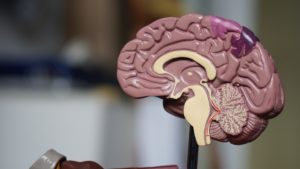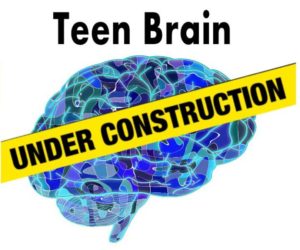This month, we are focusing on the awesome control center of the body – the brain! Our team of clinicians have weighed in on the complexities of this wonderful organ and how it continues to develop through early adulthood. Here’s Kasey Cain breaking down the brain for you!
It may seem weird, but I love talking about the brain. It is fascinating to me how our minds and bodies work. What is even more fascinating to me is that I didn’t start learning about how my brain truly worked until graduate school. Sure, I had a general anatomy class and some science discussions about the muscular system, nervous system, and respiratory system but nothing that helped me truly understand brain development. That lack of brain science education was unfortunate but luckily I have had ample opportunity to expand my learning. I am not saying I am anywhere near a neurosurgeon in my knowledge of the complexities of the brain, but I can, and have, given a lesson or presentation on the parts of the brain.
But why do I think this is so important? Often times, children feel a lack of control over their world and their  feelings. Teaching kids about their brains is a first step in giving them the power and knowledge to understand where emotions come from and begin regulating those feelings.
feelings. Teaching kids about their brains is a first step in giving them the power and knowledge to understand where emotions come from and begin regulating those feelings.
To get started, I focus on three parts of the brain: amygdala, hippocampus, and prefrontal cortex. Your amygdala is fully formed at birth and it is often referred to as the emotion center. It is part of a system that processes “reflexive” emotions like fear and anxiety. The hippocampus is like your brain’s scrapbook. It compares new learning to old learning and stores information in long term memory. The prefrontal cortex, is the CEO of the brain. It handles the executive functions – planning and organizing and regulating emotions. The prefrontal cortex does not mature until early adulthood. Because of this, children and adolescents do not always make rational decisions and cannot always control their emotions.
That brief explanation is just a place to get started. If you want to learn more, I recommend Dr. Dan Siegel and Tina Payne Bryson’s book ‘The Whole Brain Child’ and The MindUp curriculum.
As a parent, it can be extremely helpful to understand how your child’s brain is working and developing. Although as adults we are operating with a fully developed frontal lobe, our children, teens, and young adults are not and will not have a fully formed brain until the age of 25. Our frontal lobe is responsible for controlling our impulsivity, judgment, executive functioning, empathy, and personality. It then makes sense that an adolescent will not have the ability to control intense emotions in the same way that a teacher or parent can.
Unfortunately, as adults we sometimes place unrealistic or unfair expectations on our kids to respond as we would. Both kids and adults need to be taught how their brain works, especially under stress. When talking with adolescents and kids I have them shake a calming bottle and imagine the bottle as the inside of their brain when overwhelmed. When the bottle is shaken everything looks murky and unclear, just like how it may be hard for your brain to see things clearly, concentrate, or come up with a solution when overstimulated.
For more information on how the teenage brain works, I would recommend reading The Teenage Brain by Frances E. Jensen and Amy Ellis Nutt, and see what fun topics come up at your next family meal!
The brain is the CEO of the human body since it plays a massive role in how the body functions. However, that doesn’t mean that this big boss isn’t vulnerable. On its own, the brain is already a very complicated organ. When exposed to trauma, the way the brain functions becomes even more complicated. Meaning, the brain will alter the way it functions in response to being exposed to a deeply distressing or disturbing experience. The prefrontal cortex and the hippocampus may shrink, which leads to impairment with reasoning, decision-making, attention, impulsivity, emotional regulation, memory, etc.
 The amygdala, on the other hand, may increase in size and activity. When the amygdala is on high alert, it activates a fight, flight, or freeze response to stimuli that may be associated with the trauma. Now, just because these changes happen does not mean that they are permanent. Healing the brain after trauma is possible. Similar to the issues that are visible to the naked eye or that may seem more common place to seek treatment for, it does require a lot of time and consistent hard work. An even more important similarity is that it doesn’t have to be done alone and there are people out there in the world that can and want to help.
The amygdala, on the other hand, may increase in size and activity. When the amygdala is on high alert, it activates a fight, flight, or freeze response to stimuli that may be associated with the trauma. Now, just because these changes happen does not mean that they are permanent. Healing the brain after trauma is possible. Similar to the issues that are visible to the naked eye or that may seem more common place to seek treatment for, it does require a lot of time and consistent hard work. An even more important similarity is that it doesn’t have to be done alone and there are people out there in the world that can and want to help.
If you would like to read more about the relationship between the brain, body, and mental health, I would recommend reading “The Body Keeps the Score: Brain, Mind, and Body in the Healing of Trauma” by Bessel van der Kolk, M.D.
Until next time, Be Wise!
“I went home and practiced what Dr. Amy taught me…and it worked!”
— 8-year-old coaching client“This is my 1st visit at WISE with my son. So far I am very thankful and impressed by the space. I feel light and comfortable here while my son works on his growth. I appreciate that you curated the process well.” ~ WISE Family parent
— Thankful and impressed by the space“Dr. Amy brings together the best emotion-focused strategies with cutting-edge brain science to change the lives of children and families”
— Parent of adopted twin girls